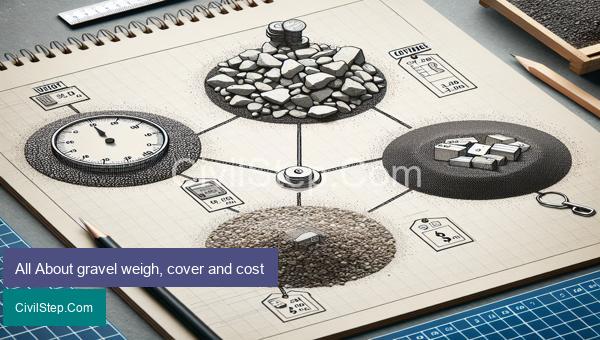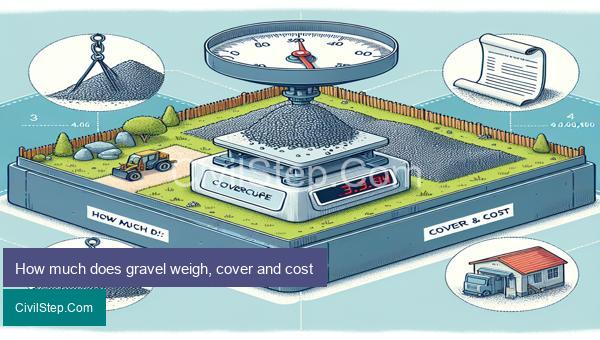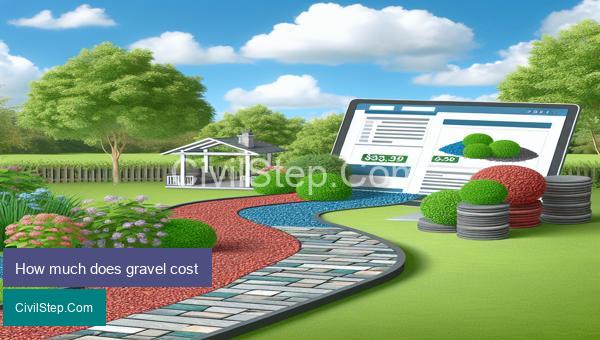
Gravel is a versatile and popular material commonly used in various landscaping and construction projects. From driveways to pathways, gravel provides a durable and attractive surface that can enhance the aesthetic appeal of any outdoor space. However, before embarking on a gravel project, it is important to have a good understanding of its weight, coverage, and cost. This article aims to provide a comprehensive guide on all aspects of gravel, including how much it weighs, how much area it can cover, and the various factors that affect its cost. By the end of this article, you will have a better understanding of gravel and be equipped with the knowledge to make informed decisions when using this material in your projects.
How much does gravel weigh, cover and cost

Gravel is a commonly used construction material that is composed of small rocks, stones, and sand. It is used in a variety of applications such as building foundations, road construction, and landscaping. Depending on the size and type of gravel, the weight, coverage, and cost can vary.
Weight:
The weight of gravel can vary depending on the type and size of the rocks used. On average, a cubic yard of gravel can weigh anywhere from 2,400 to 2,900 pounds (1,088 to 1,315 kg). This weight can also be affected by the moisture content of the gravel. Wet gravel will weigh more than dry gravel.
Coverage:
The coverage of gravel can vary depending on the size and thickness of the layer applied. Generally, one cubic yard of gravel can cover an area of about 100 square feet at a depth of 2-3 inches. This coverage can also be affected by the compaction of the gravel. A compacted layer of gravel will have less coverage compared to a loose layer.
Cost:
The cost of gravel can vary depending on the location, availability, and type of gravel. Typically, gravel is sold by the ton and the price per ton can range from $15 to $75. The cost can also be affected by the transport distance, as well as any additional fees for delivery or installation. Different types of gravel, such as pea gravel or crushed stone, can also have varying costs.
Factors Affecting Weight, Coverage, and Cost of Gravel:
1. Type of gravel: There are various types of gravel available, such as crushed stone, pea gravel, and river rock. Each type has its own unique characteristics that can affect the weight, coverage, and cost.
2. Size of gravel: The size of the gravel used can also impact its weight, coverage, and cost. Larger gravel will weigh more and have less coverage compared to smaller gravel.
3. Thickness of layer: The thickness of the layer of gravel applied will also affect its coverage and cost. A thicker layer of gravel will require more material, making it more costly.
4. Moisture content: As mentioned earlier, the moisture content of the gravel can affect its weight. Wet gravel will be heavier compared to dry gravel.
5. Compaction: A compacted layer of gravel will have less coverage compared to a loose layer. This can also affect the cost as more material will be needed to achieve the desired coverage.
In conclusion, the weight, coverage, and cost of gravel can vary depending on several factors such as the type, size, and thickness of the material. It is important to consider these factors when purchasing gravel for your construction or landscaping project. Consulting with a professional can also help you determine the appropriate amount of gravel needed for your specific project.
How much does gravel weigh

Gravel is a popular natural resource used widely in construction and landscaping projects due to its durability, versatility, and cost-effectiveness. It is an aggregate material consisting of small, irregularly shaped rocks, pebbles, and stones. Gravel is commonly found in different sizes and colors, and its weight can vary depending on these factors.
The weight of gravel is typically measured in tons or pounds per cubic yard. This is because gravel is usually sold by the cubic yard, which is a unit of volume equal to 27 cubic feet. A cubic yard of gravel can weigh anywhere from 2,400 to 2,900 pounds (1.2 to 1.45 tons), depending on the type of gravel and its size.
The type of gravel is a major determining factor in its weight. There are various types of gravel, such as crushed stone, pea gravel, and river rock, and each type has a different weight per cubic yard. For instance, pea gravel is generally lighter than crushed stone, with a weight of about 2,700 pounds per cubic yard. On the other hand, large river rocks can weigh up to 2,900 pounds per cubic yard.
The size of the gravel particles is another factor that influences its weight. Larger-sized gravel stones will weigh more than smaller ones. This is because larger particles take up more space, resulting in a higher volume and weight. For example, a cubic yard of 2-3 inch gravel may weigh about 2,800 pounds, while a cubic yard of 3/8 inch gravel can weigh around 1,350 pounds.
The moisture content of the gravel can also impact its weight. Moisture can add weight to gravel, especially if it is wet. Therefore, if you are purchasing gravel, it is essential to pay attention to its moisture content, as this can significantly affect the final weight.
In addition to these factors, the weight of gravel can also vary depending on its geographic location. This is because the density of the gravel can vary based on the source of the material and the geological conditions of the area.
In summary, the weight of gravel can range from 2,400 to 2,900 pounds per cubic yard, depending on the type, size, and moisture content. It is always recommended to consult with a professional or consult a gravel weight calculator when purchasing or using gravel in construction projects to ensure accurate measurements and appropriate use.
How much does gravel cover

Gravel is a popular choice for various construction and landscaping projects due to its versatility, affordability, and durability. It is commonly used as a base material for roads, driveways, and walkways, as well as for drainage and landscaping purposes. When planning a project that involves using gravel, one of the important factors to consider is how much gravel will be needed to cover the desired area. This can vary greatly depending on the thickness of the gravel layer and the size or type of gravel being used.
The coverage of gravel is typically measured in cubic yards (yd³) or tons. This is because gravel is typically sold in bulk and its weight can vary depending on factors such as moisture content and the size and shape of the gravel particles. The general rule of thumb for determining how much gravel is needed to cover an area is to multiply the desired depth (in feet) by the width (in feet) and the length (in feet) and then divide the result by 27 (since 1 cubic yard is equivalent to 27 cubic feet).
For example, if you have a driveway that is 10 feet wide and 50 feet long and you want to cover it with gravel to a depth of 3 inches, the calculation would be as follows:
10 ft (width) x 50 ft (length) x 0.25 ft (depth) = 125 ft³
125 ft³ ÷ 27 = 4.63 yd³
This means you will need approximately 4.63 cubic yards of gravel to cover your driveway.
It is important to note that the recommended depth for gravel coverage can vary depending on the intended use and the type of gravel being used. For example, for driveways and walkways, a depth of 2-3 inches is generally recommended, while for drainage purposes, a depth of 6-8 inches may be needed. It is best to consult with a professional or follow the recommendations of the gravel manufacturer for the specific project you are undertaking.
The size and type of gravel being used can also affect the coverage. Larger sized gravels will take up more space and therefore require less depth to cover an area compared to smaller sized gravels. Similarly, different types of gravel, such as crushed stone or pea gravel, may have varying weights and densities, which can impact the calculation.
In addition to the area coverage, it is also important to consider the appropriate depth for the gravel layer. A thicker layer of gravel can provide better stability and support, but it can also increase the cost and limit drainage capabilities. On the other hand, a thinner layer may be more affordable but may not provide adequate coverage or stability. It is important to find the right balance between these factors to ensure a successful and cost-effective project.
In conclusion, the amount of gravel needed to cover an area can vary based on factors such as the desired depth, size and type of gravel, and the intended use. It is important to carefully calculate the coverage and depth needed for your project to ensure its success and to avoid unnecessary expenses. As a civil engineer, I understand the importance of proper planning and calculation in any construction project, and the same applies to the use of gravel. By considering all these factors and using the appropriate techniques, you can determine the right amount of gravel needed for your project and achieve the desired results.
How much does gravel cost

Gravel is a versatile and commonly used construction material made of small, loose rock particles. It is often used in road construction, landscaping, and as a base material for concrete and asphalt. When planning a project that requires the use of gravel, it is important to consider the cost of this material.
The cost of gravel can vary depending on several factors such as quality, type, and location. In general, the average cost of gravel ranges from $10 to $50 per ton. However, there are other factors that can affect the final cost, including delivery fees, taxes, and transportation costs.
The type of gravel being used is a major factor in determining its cost. Gravel can be classified into different categories based on its size and composition. The most commonly used types of gravel are crushed stone, pea gravel, and river rock.
Crushed stone is made by crushing larger rocks into smaller pieces and is known for its angular edges. It is commonly used as a base material for driveways, roads, and parking lots. This type of gravel is typically more expensive, with prices ranging from $15 to $75 per ton.
Pea gravel, on the other hand, is a smaller, more rounded type of gravel. It is usually used for decorative purposes such as in landscaping and walkways. Its cost ranges from $20 to $50 per ton.
River rock is a larger, more decorative type of gravel that is often used in landscaping and as a drainage material. It can be found in various colors and sizes, and its cost ranges from $25 to $75 per ton.
Aside from the type of gravel, the quality of the material also affects its cost. Gravel with higher quality and durability will generally be more expensive. It is important to consider the intended purpose of the gravel and choose a quality level that is suitable for your project to ensure its longevity.
Location also plays a significant role in the cost of gravel. The price of gravel can vary from one region to another due to factors such as supply and demand, availability of sources, and transportation costs. It is always a good idea to get quotes from different suppliers in your area to compare prices and find the most cost-effective option.
In addition to the cost of the gravel itself, there are other fees that may be included in the final cost. These may include delivery fees, taxes, and transportation costs. These fees can add up quickly, especially if you are purchasing a large quantity of gravel.
In conclusion, the cost of gravel can vary greatly depending on factors such as type, quality, and location. It is essential to consider these factors when planning a project that requires the use of gravel. By doing some research and getting quotes from different suppliers, you can find the most cost-effective option for your project.
Conclusion
In conclusion, gravel is a versatile and affordable option for all types of landscaping and construction projects. Knowing the weight, coverage, and cost of gravel can help in planning and budgeting for these projects. It is important to consider the type and size of gravel, as well as the area to be covered, when determining the amount of gravel needed. Additionally, understanding the different types of gravel allows for a more informed decision on the best option for your specific project. While the cost of gravel may vary depending on location, it remains a cost-effective and durable material that can add both functionality and aesthetic appeal to any outdoor space. Hopefully, this article has provided useful information for anyone looking to incorporate gravel into their next project.
